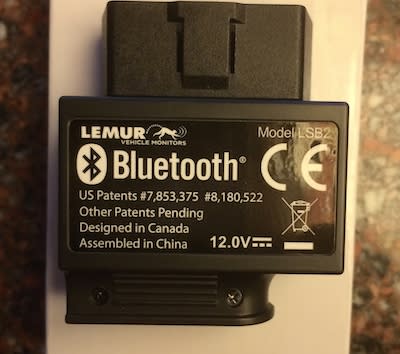Lemur Monitors BlueDriver: Get to know your vehicle better

A while back I wrote about Automatic's device and app for tracking your driving. Now comes a similar device for troubleshooting your favorite vehicles through an iOS app -- the US$99.99 Lemur Monitors BlueDriver. As with the Automatic device, BlueDriver plugs into the On Board Diagnostics (OBD) port in your car (1997 or later), then uses Bluetooth to transmit information to the app for viewing and/or capturing.
The difference between the two devices? Well, they're both about the same size, they're the same price, and they both come with an app. However, the Automatic device and app are more oriented towards making sure that you create safe and efficient driving habits over the long term, while BlueDriver is aimed more at either instant identification of what that "Check Engine" light means or for logging performance info.
Using BlueDriver is easy. You plug the BlueDriver dongle into the OBD port (usually found under the steering wheel), fire up the app, and the two devices communicate.
The app initially presents the user with a set of buttons, all of which perform a specific function. Read & Clear Codes lets you view diagnostic trouble codes (DTCs) that are triggering your Check Engine light, clear those codes, and will also provide diagnostic codes for ABS systems on Ford, GM and Chrysler vehicles. Repair Reports generates a report for each DTC that gives car owners possible causes of the glitch as well as the top, frequent, and other reported fixes. Freeze Frame creates a snapshot of conditions that occurred when a Freeze Frame Code was stored by your car's computer.
Wondering if your car is going to pass the next emissions check? There's a button in this app for that. Tap on Smog Check, and you'll know quickly whether you'll have to get your car into the shop for work before the smog test. Then there's the ominous-sounding Mode 6, which is a set of advanced test results for OBD system monitors. Finally, and probably the thing that car enthusiasts most want to see, there's Live Data. This mode lets you capture and share any live data that's supported by your vehicle.
Live Data takes a snapshot of a number of supported data points for your car every 1.2 seconds. You can either watch the data "live" on your iPhone (hopefully you're paying attention to your driving instead) or send yourself a .CSV file at the end of the session. In a short drive around the block the app captured 108 sets of readings, each with information on fuel system status, calculated engine load, engine coolant temperature (in both °F and °C), short and long term fuel trim percentage, intake manifold absolute pressure (in both kPa and inHg), engine RPM, vehicle speed (in both km/h and MPH), timing advance for the #1 cylinder, intake air temperature (°F and °C), mass air flow rate (lb/min and g/s), and absolute throttle position. There were more items I could have added to the list, but for testing purposes I felt these were enough.
I was able to make practical use of the BlueDriver during my testing -- at one point, my wife told me that her car had made the proverbial "weird noise" just before she started it to go to work. I was able to plug in the unit, start the car up, connect, and then show her that everything was just fine.
Conclusion
In many ways I see the Lemur Monitors BlueDriver as the perfect companion device and app for Automatic's unit. Most of the time, you'll want to know where and how you drove, what your gas mileage was like, and so on -- that's where Automatic shines. But when you want to give your car a checkout or you're interested in improving its performance, BlueDriver is perfect. I highly recommend BlueDriver for the car enthusiast or weekend mechanic who likes to know what's going on underneath the hood of their car.
Rating: 4 stars out of 4 stars possible


